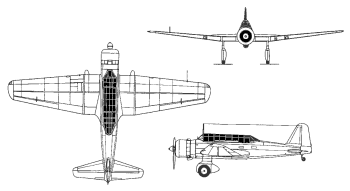



Similar in role to the Fairey Battle, the Mitsubishi Ki-30 'Ann' was designed as a single-engine light bomber as part of the IJAAF's ambitious modernization and expansion program during the mid-1930s which intended to substitute the older wooden biplanes with all-metal stressed-skin monoplanes. Compared to the Battle, the Ki-30 was smaller, lighter, and more agile although its mid-wing design required long non-retractable undercarriage legs which affected performance. Still, the 'Ann' was notable in being the first Japanese aircraft with a modern two-row engine and internal bomb bays. Despite destinguished service in China, it was only used extensively during the initial campaigs such as the Philippines where its increasing vulnerability forced it into training duties and, later, kamikazes. It was also supplied to Thailand for use against Vichy French forces in Indo-China.
First flight of the prototype 'Ann' took place on 28 February 1937 with a Mitsubishi Ha-6 engine, later upgraded in production versions of which the Ki-30 was the only production variant, built by both Mitsubishi and the Tachikawa Army Air Arsenal.
Preceded by:
NoneSucceeded by:
None | |
| Design | Ki-30 |
| Code Name | Ann |
| Type | Light Bomber |
| Year | 1938 |
| Crew | 2 |
| Dimensions | |
| Length | 10.34 m |
| Height | 3.650 m |
| Wing Span | 14.55 m |
| Wing Area | n/a |
| Weight | |
| Empty | 2,230 kg |
| Maximum | 3,322 kg |
| Wing Loading | 108.6 kg/m² |
| Performance | |
| Speed | 423 km/h |
| Ceiling | 8,570 m |
| Range | 1,700 km |
| Powerplant | |
| Engine | 1 x Ha-5 KAI Nakajima 716 kW |
| Thrust/Weight | 0.39 |
| Armament | |
| Guns | 2/3 x 7.7-mm |
| Payload | 400 kg |
| Production | |
| Built | 686 |
| Total | 704 |